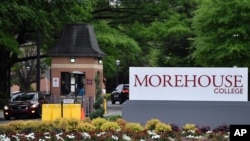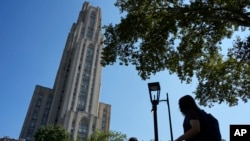Student Union
Limited Funds or No English? No Problem at Community Colleges

Community colleges -- sometimes seen as a lesser alternative for college students -- can get many students started on a more flexible and less costly path toward a degree.
These schools offer an associate’s degree in two years that is transferable to many four-year institutions for a bachelor’s degree. Once called junior colleges, they popped up in the U.S. around the turn of the 1900s.
The biggest draw of community colleges is their affordability.
While the average tuition at public four-year schools for the 2017-2018 academic school year was $26,261, and $46,014 at private institutions, according to the National Center for Education Statistics, those numbers understate the cost of many private competitive universities.
The most expensive four-year universities in the U.S. include Amherst College ($82,008) and Tufts University ($70,000), both in Massachusetts. Third runner-up is Franklin and Marshall College in Pennsylvania ($60,872), according to their websites.
And that doesn’t include room and board, which, at Tufts, adds another $8,516 to the price.
But at community colleges, the average cost of a two-year school was $3,564, according to the National Center for Education Statistics. Some community colleges in recent years have offered free tuition in Arkansas, California and Delaware.
“It's a gateway for many students to transfer to the university,” said Martha Parham, the senior vice president of public relations at the American Association of Community Colleges in Washington, D.C.
“If they take their first two years at community college, it's a significant cost savings. You know, as well as it's affordable, it's accessible, it's a great place to go,” she said.
While they are not as academically competitive as most four-year institutions, they offer students a chance to take courses that may not be related to their career aspirations, but are required, such as chemistry and algebra.
And for commuter, working and part-time students who live at home or off campus more cheaply than on campus, the savings is significant as they can attend classes at their pace and time of day.
The majority of students enrolled in community colleges work, Parham said.
About 80% of community college students have a job, with 39% working full time.
“It's an on-ramp to the middle class for many of our students who otherwise, you know, wouldn't have the same opportunity,” Parham said.
Other advantages include flexibility in scheduling and lower academic requirements. Community colleges are located, as their name implies, mostly in areas where there is a cluster of students who can access them more easily than other schools.
Students can attend a community college more easily while they work, tend to family or lack the means to move farther away to a school that offers room and board. The average age of a student in community college is 28-years-old, Parham said.
“I personally didn't feel ready enough yet to go off to a big university, because I just felt like I didn't have that structure to be able to go into a higher institution like that,” said Ella Paredes, a sophomore political science major at Miami Dade College in Florida.
Paredes, who commutes to community college from home, said she plans to transfer to Florida State University in Tallahassee for her bachelor’s degree after she graduates in Spring 2021 from Miami Dade College.
“My advice to students would be to work backwards and understand you know kind of your ultimate goal and then plan accordingly to make sure that the classes that you take, and the institution you attend, has those articulation agreements to ensure that you have a smooth transfer,” Parham said.
Alejandro Canas, a film production major, is going to be a sophomore in Spring 2021 at Santa Monica College (SMC) in California. In the meantime, he is taking his courses online from home in Jalisco, Mexico.
Community college is an American invention. The first was Joliet Junior College in Joliet, Illinois, which serves more than 30,000 students today.
It’s “something new, especially if you are from a different culture or from a country that is different. It's really important because you will expand your knowledge,” Canas said.
“You will see that community college is not just about studying, it's about expanding your experience, expanding your skills, and getting closer to different kinds of people you know,” he said.
Many community colleges, such as Santa Monica College and Northern Virginia Community College, have resources and courses available for students whose primary or first language is not English. Many community colleges don’t require English language skills for admission and will teach students based on their proficiency or lack of it.
Canas had about 60% proficiency in the English language when he began at SMC and credits his community college professors and available resources for helping him improve his English during his studies.
Community colleges offer tutoring, and teachers are prepared to help accommodate students who may be still learning English. Many community colleges have an English as Second Language (ESL) program centered around helping students whose first language is not English, according to the U.S. Department of State’s EducationUSA branch.
Only about 7.4% of the more than 1 million international students enrolled in U.S. institutions of higher education attend community colleges, according to the Institute for International Education. Most international students may not be aware of the advantages.
Many community colleges have articulation agreements with universities, meaning four-year schools have agreed to honor most if not all of the students’ credits.
“It's a great way for international students to come study in the United States, get their first two years of their degree done at a place with smaller class sizes, more affordable,” Parham said.
During the 2019-2020 academic school year there were 79,187 international students at colleges offering an associate's degree in the U.S., according to IIE.
The Houston Community College System has the largest number of international students among community colleges in the U.S., with 4,723 international students enrolled in the 2019-2020 school year.
China was the leading place of origin for international students attending community colleges, comprising 18.6% of international community college students in the 2019-2020 school year.
Vietnam was the second-leading place of origin, making up 10% of the total international community college student population.
Overall, however, international students at U.S. community colleges declined 8.3% from the previous academic year.
Parham points to the pandemic and recent federal travel restriction policies as explanation for the decline. For all international student enrollment at all U.S. institutions of higher learning, the decline for the 2020-2021 school year has been 43%, according to IIE.
See all News Updates of the Day
- By VOA News
Competition grows for international students eyeing Yale

It’s tough to gain admission to Yale University, and it’s getting even tougher for international students as standout students from around the world set their sights on Yale.
The Yale Dale News, the campus newspaper, takes a look at the situation here.
- By VOA News
Student from Ethiopia says Whitman College culture made it easy to settle in

Ruth Chane, a computer science major from Ethiopia, writes about her experiences settling into student life at Whitman College in the U.S. state of Washington.
"The community at Whitman College made sure I felt welcomed even before I stepped foot on campus," she says.
- By VOA News
Claremont Colleges student gets a shock when she heads home to Shanghai

In The Student Life, the student newspaper for the Claremont Colleges, a consortium of five liberal art colleges and two graduate schools in Claremont, California, student Rochelle Lu writes about readjusting to her Shanghai home after spending a semester in the United States.
- By VOA News
Cedarville University aims to ease transition for international students

Cedarville University in the U.S. state of Ohio says it’s got more than 140 international students representing 44 countries.
Here, the school interviews Jonathan Sutton, director of international student services. He talks about his job and the opportunities for international students on campus.
- By VOA News
Morehouse College offers prospective students tips on applying and thriving

Morehouse College, a private, historically Black liberal arts college in the U.S. state of Georgia, offers a guide for international students interested in attending the school.
Among the tips to apply and thrive at Morehouse:
- Take advantage of the school’s orientation program
- Turn to the school’s Center for Academic Success for tutoring, support and more
- Immerse yourself in campus life via clubs and societies
- By Reuters
US reviews Columbia University contracts, grants over antisemitism allegations

The administration of President Donald Trump said on Monday it will review Columbia University's federal contracts and grants over allegations of antisemitism, which it says the educational institution has shown inaction in tackling.
Rights advocates note rising antisemitism, Islamophobia and anti-Arab bias since U.S. ally Israel's devastating military assault on Gaza began after Palestinian Hamas militants' deadly October 2023 attack.
The Justice Department said a month ago it formed a task force to fight antisemitism. The U.S. Departments of Health and Education and the General Services Administration jointly made the review announcement on Monday.
"The Federal Government's Task Force to Combat Anti-Semitism is considering Stop Work Orders for $51.4 million in contracts between Columbia University and the Federal Government," the joint statement said.
The agencies said no contracting actions had been taken yet.
"The task force will also conduct a comprehensive review of the more than $5 billion in federal grant commitments to Columbia University."
The agencies did not respond to requests for comment on whether there were similar reviews over allegations of Islamophobia and anti-Arab bias.
Columbia had no immediate comment. It previously said it made efforts to tackle antisemitism.
College protests
Trump has signed an executive order to combat antisemitism and pledged to deport non-citizen college students and others who took part in pro-Palestinian protests.
Columbia was at the center of college protests in which demonstrators demanded an end to U.S. support for Israel due to the humanitarian crisis caused by Israel's assault on Gaza. There were allegations of antisemitism and Islamophobia in protests and counter-protests.
During last summer's demonstrations around the country, classes were canceled, some university administrators resigned and student protesters were suspended and arrested.
While the intensity of protests has decreased in recent months, there were some demonstrations last week in New York after the expulsion of two students at Columbia University-affiliated Barnard College and after New York Governor Kathy Hochul ordered the removal of a Palestinian studies job listing at Hunter College.
A third student at Barnard College has since been expelled, this one related to the occupation of the Hamilton Hall building at Columbia last year.
Canada’s immigration overhaul signals global shift in student migration
From Europe to North America, nations are tightening their immigration policies. Now Canada, long seen as one of the world's most welcoming nations, has introduced sweeping changes affecting international students. The reforms highlight a growing global trend toward more restrictive immigration policies. Arzouma Kompaore reports from Calgary.
Trump administration opens antisemitism inquiries at 5 colleges, including Columbia and Berkeley

The Trump administration is opening new investigations into allegations of antisemitism at five U.S. universities including Columbia and the University of California, Berkeley, the Education Department announced Monday.
It's part of President Donald Trump's promise to take a tougher stance against campus antisemitism and deal out harsher penalties than the Biden administration, which settled a flurry of cases with universities in its final weeks. It comes the same day the Justice Department announced a new task force to root out antisemitism on college campuses.
In an order signed last week, Trump called for aggressive action to fight anti-Jewish bias on campuses, including the deportation of foreign students who have participated in pro-Palestinian protests.
Along with Columbia and Berkeley, the department is now investigating the University of Minnesota, Northwestern University and Portland State University. The cases were opened using the department's power to launch its own civil rights reviews, unlike the majority of investigations, which stem from complaints.
Messages seeking comment were left with all five universities.
A statement from the Education Department criticized colleges for tolerating antisemitism after Hamas' Oct. 7, 2023, attack on Israel and a wave of pro-Palestinian protests that followed. It also criticized the Biden administration for negotiating "toothless" resolutions that failed to hold schools accountable.
"Today, the Department is putting universities, colleges, and K-12 schools on notice: this administration will not tolerate continued institutional indifference to the wellbeing of Jewish students on American campuses," said Craig Trainor, the agency's acting assistant secretary for civil rights.
The department didn't provide details about the inquiries or how it decided which schools are being targeted. Presidents of Columbia and Northwestern were among those called to testify on Capitol Hill last year as Republicans sought accountability for allegations of antisemitism. The hearings contributed to the resignation of multiple university presidents, including Columbia's Minouche Shafik.
An October report from House Republicans accused Columbia of failing to punish pro-Palestinian students who took over a campus building, and it called Northwestern's negotiations with student protesters a "stunning capitulation."
House Republicans applauded the new investigations. Representative Tim Walberg, chair of the Education and Workforce Committee, said he was "glad that we finally have an administration who is taking action to protect Jewish students."
Trump's order also calls for a full review of antisemitism complaints filed with the Education Department since Oct. 7, 2023, including pending and resolved cases from the Biden administration. It encourages the Justice Department to take action to enforce civil rights laws.
Last week's order drew backlash from civil rights groups who said it violated First Amendment rights that protect political speech.
The new task force announced Monday includes the Justice and Education departments along with Health and Human Services.
"The Department takes seriously our responsibility to eradicate this hatred wherever it is found," said Leo Terrell, assistant attorney general for civil rights. "The Task Force to Combat Anti-Semitism is the first step in giving life to President Trump's renewed commitment to ending anti-Semitism in our schools."
- By VOA News
STEM, business top subjects for international students

The Times of India breaks down the most popular subjects for international students to study in the U.S.
STEM and business lead the pack. Read the full story here. (January 2025)
- By VOA News
Safety and visa difficulties among misconceptions about US colleges

U.S. News & World report addresses some of the misconceptions about U.S. colleges and universities, including the difficulty of getting a visa.
Read the full story here. (January 2025)
- By VOA News
Work opportunities help draw international students to US schools

US News & World Report details the three top factors in foreign students' decision to study in the U.S. They include research opportunities and the reputation of U.S. degrees. Read the full story here. (December 2024)
- By VOA News
British student talks about her culture shock in Ohio

A British student who did a year abroad at Bowling Green State University in Ohio talks about adjusting to life in America in a TikTok video, Newsweek magazine reports.
Among the biggest surprises? Portion sizes, jaywalking laws and dorm room beds.
Read the full story here. (December 2024)
- By VOA News
Harvard's Chan School tells international students what to expect

Harvard's T.H. Chan School of Public Health reaches out to international students by detailing the international student experience at the school.
Learn more about housing, life in Boston and more here.
- By Reuters
China unveils plan to build 'strong education nation' by 2035

China issued its first national action plan to build a "strong education nation" by 2035, which it said would help coordinate its education development, improve efficiencies in innovation and build a "strong country."
The plan, issued Sunday by the Communist Party's central committee and the State Council, aims to establish a "high quality education system" with accessibility and quality "among the best in the world."
The announcement was made after data on Friday showed China's population fell for a third consecutive year in 2024, with the number of deaths outpacing a slight increase in births, and experts cautioning that the downturn will worsen in the coming years.
High childcare and education costs have been a key factor for many young Chinese opting out of having children, at a time when many face uncertainty over their job prospects amid sluggish economic growth.
"By 2035, an education power will be built," the official Xinhua news agency said, adding that China would explore gradually expanding the scope of free education, increase "high-quality" undergraduate enrolment, expand postgraduate education, and raise the proportion of doctoral students.
The plan aims to promote "healthy growth and all-round development of students," making sure primary and secondary school students have at least two hours of physical activity daily, to effectively control the myopia, or nearsightedness, and obesity rates.
"Popularizing" mental health education and establishing a national student mental health monitoring and early warning system would also be implemented, it said.
It also aims to narrow the gap between urban and rural areas to improve the operating conditions of small-scale rural schools and improve the care system for children with disabilities and those belonging to agricultural migrant populations.
The plan also aims to steadily increase the supply of kindergarten places and the accessibility of preschool education.
- By VOA News
A look at financial aid options for international graduate students in US

The Open Notebook, a site focusing on educating journalists who cover science, has complied a list of U.S. graduate program financial aid information for international students.








